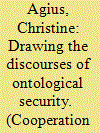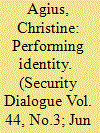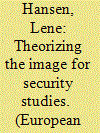|
|
|
Sort Order |
|
|
|
Items / Page
|
|
|
|
|
|
|
| Srl | Item |
| 1 |
ID:
151182


|
|
|
|
|
| Summary/Abstract |
The controversy of the Danish cartoon crisis in 2006 overshadowed a similar one that took place in Sweden a year later. The crises have broadly been framed as a clash of values but both cases reveal differences worthy of investigation, namely for the complex tensions and convergences between the two states on questions of immigration, Nordic solidarity and national identity. This article aims to explore the intersubjective discourses of identity that were threaded through the debates on the cartoon crises, looking to the overlapping discourses that have constructed ideas of identity in terms of ontological security, or security of the self. It argues that both cartoon crises represent a complex discursive performance of identity that speaks to a broader set of ontological security concerns which intersect at the international, regional and national levels. Even in their differences, Swedish and Danish discourses show the tensions associated with the desire for a stable and consistent idea of self when contrasted with the Muslim ‘other’, explored in the context of discourses of modernity and tolerance, which operate as key sites that work to reiterate, reclaim and reinstate the idea of the progressive state.
|
|
|
|
|
|
|
|
|
|
|
|
|
|
|
|
| 2 |
ID:
121824


|
|
|
|
|
| Publication |
2013.
|
| Summary/Abstract |
The Danish cartoon crisis, which attracted international media attention in 2006, has largely been debated as an issue of freedom of speech, feeding into broader debates about the 'clash of civilizations'. This article aims to explore the dominant discourses that performed a seemingly stable and consistent Danish identity at the domestic and external levels. Domestically, the discourse of a progressive Danish identity under threat from unmodern others was performed via discourses of a 'culture struggle' and a restrictive immigration policy designed to keep intact a narrow definition of Danishness. Externally, Danish identity and security was performed and defended via participation in the 'war on terror', democracy promotion and overseas development assistance, which became tools that were not simply associated with security in the liberal sense but also contained a spatial dimension designed to keep consistent the image of the complete nation-state. By adopting a discursive approach, the article aims to explore the performance of Danish identity that animated the cartoon crisis in order to highlight the complexities and contestations that animate ideas of self.
|
|
|
|
|
|
|
|
|
|
|
|
|
|
|
|
| 3 |
ID:
103666


|
|
|
|
|
| Publication |
2011.
|
| Summary/Abstract |
This article provides a framework for the study of visual securitization, that is, when images constitute something or someone as threatened and in need of immediate defense or when securitizing actors argue that images 'speak security'. To study security politics is to focus on the public constitution of threats and dangers; to study visual securitization, therefore, requires an analysis not just of the image as a free-standing entity, but of the ways it is constituted through spoken and written discourse. To analyze the process of visual securitization, this article advances an inter-visual/intertextual model consisting of four components: the visual itself, its immediate intertextual context, the wider policy discourse, and the constitutions of the image. Three additional sets of theoretical arguments deepen this model by pointing to the specificity of the image as comprised through immediacy, circulability, and ambiguity, the strategies of depiction that images employ, and the genres through which images are brought to the audience. The applicability of the theoretical framework is illustrated through a case study of one of the most conspicuous cases of visual securitization: the Muhammad Cartoon Crisis.
|
|
|
|
|
|
|
|
|
|
|
|
|
|
|
|
|
|
|
|
|